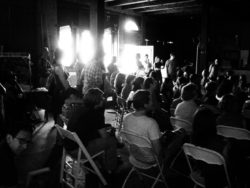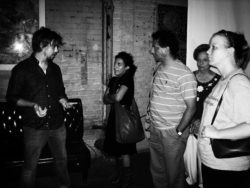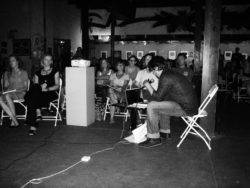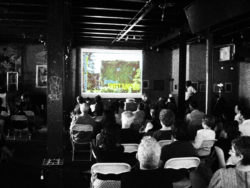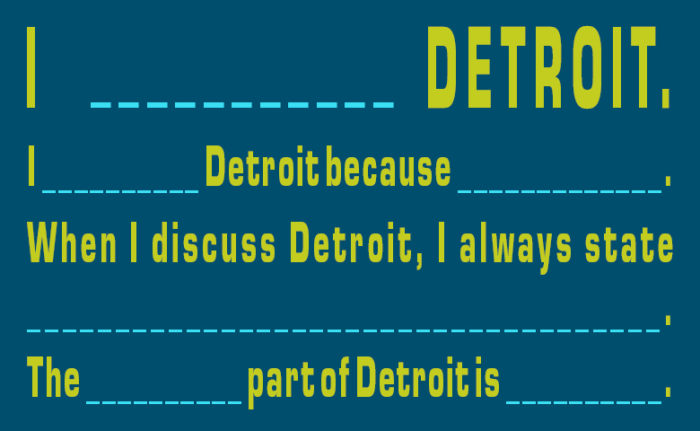SWEET JUNIPER POST LECTURE DISCUSSION
lecturesHAA : Event 2. When Jim Griffioen began his August 18th lecture at the Johanson Charles Gallery, every folding chair was filled, additional people stood along the perimeter, and a few kids were heard playfully giggling amongst the adult masses. All were there to witness Sweet Juniper’s first official lecture. Jim’s heavily frequented blog, www.sweet-juniper.com, often ruminates on a multitude of themes that compose his intimate Detroit experience. The lecture promised to be a larger, more congruent narrative that tied his sometimes disparate topics together.
Sweet Juniper! A cacophony of revolutionary images flashed upon the screen: Michigan Theatre Parking Garage, Greenfield Village, Joseph Gandy’s “Bank of England in Ruin”, Detroit ruins, men in yellow sports jackets and seer sucker shorts, Michigan Central Depot, Conan the Barbarian, Detroit ruins, another classical painting “Syria by the Sea”, Roman Ruins, English landscape gardens, Detroit ruins, open fields surrounding a solitary house, and finally more Detroit ruins. His Detroit photographs are stoic, beautiful, and common. Jim is the first to admit that hundreds of CCS art students, musicians, architects, designers have been taking these same images for decades. Abandoned houses left to grow feral. Iconic landmarks ravaged by looters. Schools shuttered and forgotten. Books mounded on a pvc tile floor with a single tree growing amongst the detritus. These images rarely contain humans – an occasional stray dog or errant pheasant – but hardly a human. It is this void, the lack of human life, which results in a blank narrative, an image in need of a story.
To the beat of these steady images, Jim Griffioen begins to fill in the blanks. He flips through a few more slides and a few more blanks are filled. We begin to sense a strategy – a story. Jim is telling his story, specific to how he and his family approach living in Detroit, amongst the remains of a former industrial powerhouse. He further explains how he and his family are beginning to “own these ruins of Detroit”. He proposes the creation of parks amongst the most prominent abandoned structures. Similar to Roman tourism, visitors flock to see Detroit ruins, why not create a park accentuating these relics? He mentions utilizing these empty Detroit monuments through paid, guided urban exploration. In summary, Sweet Juniper! proposes that if Rome can accept the fall of their empire, appreciate the wreckage resulting from a transference of power, and then market their architectural remains…perhaps Detroit can follow suit.
Mad Lib Detroit. With the conclusion of his last image, Jim’s voice subsided and his eloquent sermon was over. He was met with a long moment of silence, and an equally long round of applause, before a series of questions were asked by the public. Each question stemmed from obvious mixed emotions: enthusiasm, anger, appreciation, confusion, and skepticism. Jim’s photography gives us a Mad Lib Detroit: the children’s phrasal template word game revamped to accommodate our post-industrial city. All the previously listed emotions are accurate substitutions in Detroit’s Mad Lib game. In this game, there is no history, no narrative. Irony abounds as Detroit has an overabundance of history; everyone in the gallery knows this. But there is freedom in Sweet Junipers!’s work, suddenly Detroit has no record and anyone can insert their selective history, narrative, or memory. Detroit becomes a Mad Lib city, with a reputation that fluctuates in accordance to one’s inserted narrative.
Jim’s lecture and the subsequent discussions remind us that no two Detroit narratives are alike. More importantly, broad creative discourse results in open and collaborative dialogue. Only then can we effectively participate in the thoughtful, creative regeneration of Detroit.
What is your narrative? What do propose for the city of Detroit? What is your strategy?
Mad Lib Urbanism. As designers, the voids of a city call to us. Abandoned structures are romanticized. Interstitial spaces require resolution. To further our Mad Lib analogy, Detroit is filled with physical blanks. But more importantly, how does one design for these intangible, interstitial spaces found between disparate Detroit narratives? As a child, one could develop a strategy for filling in all of their Mad Lib blanks: your own name, your current crush’s name, profanity, etc. As Detroit designers, do we develop similar strategies? Do we fill in each of these blanks with sustainable design, urban farming, etc? With such a childlike strategy, the city would become homogeneous and overly simplified. Detroit would become a blasé marketing slogan. To prevent this generality, the first step towards intelligent Detroit advancement begins with honest discourse and an appreciation of each other’s narrative. The tensions need to be acknowledged.
As Detroit residents, we need to improve our creative, multidisciplinary discourse; otherwise mass media will complete our narrative and fill in the blanks for us.





